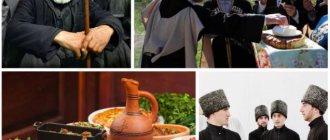A Spanish wedding is a unique celebration in which modern trends are closely intertwined with ancient traditions and customs, characteristic only of the inhabitants of this country. They are a reflection of the passionate Spanish soul, hot temperament and devotion to family values. This is what distinguishes celebrations in hot Spain from the rather restrained European weddings that everyone is accustomed to.
The Svadbaholik.ru portal offers a closer look at the unique customs and features of holding a wedding in bright and sunny Spain. Depending on the region of the country, traditions may differ from each other, but the basics of celebrations comply with established rules.
Spanish wedding dresses
Wedding traditions in Spain affect not only the ceremony, but also the choice of dress for the bride, which, by the way, is usually bought by the groom.
According to all the most ancient canons, the classic bride's dress should be black. In Spain, this color symbolizes love and devotion to one's husband until death. However, not everyone likes this now! Some girls, following custom, buy a white dress for themselves, but add black elements to it.
Most often, modern brides prefer a white outfit, less often - red. Many girls choose a wedding dress in the traditional Spanish style - flamenco, the distinctive features of which are both the style and the unusual diagonal cut. The fitted top of the dress, a fluffy skirt and an abundance of flounces emphasize the silhouette and add uniqueness to the bride’s image.
The founders of flamenco are the Spanish gypsies. As a result of the interaction of two cultures and traditions, an unsurpassed, vibrant and unique style emerged. Perhaps this is why the Spaniards celebrate weddings so magnificently and on a grand scale.
One of the most important details of a Spanish wedding look is the traditional lace veil - mantilla, which looks incredibly gentle and romantic.
Wedding concept and style
We wanted to bring Spanish notes into our holiday, since we both love Spain very much, and immediately after the wedding we fulfilled our dream and moved to this country of sea and sun. The palette was dominated by muted, calm tones. In addition to green and white, the design included powder, shades of olive and sand.
We thought for a long time about how to guess with the weather and the venue - we wanted an open-air celebration, but at the same time we didn’t want to take risks, what if it rained and was cold? And then we found a 2 in 1 site: a country hotel, surrounded by greenery, with a banquet hall on the sixth floor with access to the roof. So our gala dinner was held indoors, and the dancing and all the activities were outdoors.
Spanish style wedding
Imbued with the spirit and traditions of a bright and sunny country, newlyweds from all over the world often want to add these special notes to their celebration. A Spanish-style wedding will be remembered for a long time not only by the young people, but will also leave pleasant memories for all guests. Good and interesting traditions will only brighten the holiday of love.
A wedding filled with touching rituals elevates the celebration to a sacred level. The symbolism of love and happiness surrounds the young. A riot of colors and fireworks of emotions create a unique atmosphere. The scale of the celebration in the Spanish style will not leave anyone indifferent.
To organize such a unique wedding, you don’t have to go to Spain. You just need to borrow the interesting traditions you like, add bright decorations, choose a themed wedding dress in the flamenco style - and your unforgettable holiday is ready!
The portal www.svadbagolik.ru is confident that anyone can organize a wedding even in the most unusual style, and a piece of magnificent Spain will make your holiday truly colorful and unique.
Wedding in Spanish
When preparing this material, I tried to read all the information that is on the Internet in Russian and Spanish called “ Spanish wedding ”! As always, I was amazed by the huge amount of Internet garbage, collecting all the plausible nonsense and unverified speculation on any issue, including, as Vladimir Vysotsky sang, “gossip in the form of versions.”
I know about the Spanish wedding and its organization first-hand, but literally everything, thoroughly. Although, of course, a share of subjectivity in my story is inevitable. Contrary to all the assurances of numerous marriage agencies, who claim that they will help you find Spanish groom, and soon get married to him, and know all the “ins and outs” in this difficult matter, I want to argue with them. To marry a Spaniard (and not enter into a fictitious marriage, improve your financial situation, solve problems of immigration or self-realization), you need a miracle to happen! This miracle is called Love!
My opinion completely coincides with the opinion of all my Spanish . I am sure that this miracle should happen even if you want to marry an Indian, Cypriot or Portuguese, not to mention a selected Russian groom! You may argue that there may be different interpretations on this matter, but I insist on my own and believe that marriage with a Spaniard can be concluded ONLY if there is the first and main condition - mutual LOVE and the second, no less important point - a serious desire to start a family!
How and why this coincidence happens is a mystery, so let’s move on to the next point in my story - organizing the wedding. The scale and enchantment of the event depends, again, on two conditions. The first is how the bride and groom see their wedding, and the second is how things stand with the material possibilities for implementing all sorts of fantastic plans for organizing such a wonderful celebration.
Traditionally, most marriages in Spain take place in a church. A marriage celebrated in a church is considered to be just as official and valid as a marriage celebrated in a municipality. In this case, thank God, there is no “separation of state and church”! The Catholic Church allows marriage between Christians, without insisting on the conversion of the Orthodox spouse to the Catholic faith. That is, an Orthodox bride or groom has the right to register their marriage with a Catholic. But one of the conditions for such a marriage is the consent of the Orthodox party that children born in marriage will be baptized in a Catholic church.
After the Wedding Ceremony Day is set, the future spouses must attend several classes at the “School for Brides and Grooms” at the church. Several couples come to this school for lessons and, in a very modern form and without oppressive threats for disobedience, receive advice from the priest - how, based on Christian commandments, you need to build family relationships and what marriage is in the eyes of the church. Modern future newlyweds, often quite skeptical of all moral teachings and edifications, and especially on the question of “how to live correctly with a husband or wife,” are pleasantly surprised by the “kura” (priest) who teaches the lessons. In a very pleasant manner, with humor, in an accessible form adapted to modern life, the “kura” does not edify, but rather tells brides and grooms how, based on the Holy Scripture, to feel and understand the importance of the upcoming wedding event, and what to do actually means such an important step as marriage, and what is a family and the roles of the wife and husband in it.
Of course, as in all countries of the world, the parents of the bride and groom meet. It should be noted that the general benevolent mood of the Spaniards towards the future spouse of their child has deep roots. Firstly, marriage in Spain is a matter of the highest degree of importance and seriousness. At the same time, parents always stand on the side of their daughter or son, sharing his choice, even if they don’t really like something about their child’s chosen one or chosen one. Respect and internal culture do not allow parents not only to put obstacles in their way of their child, but even to speak negatively about their future spouse. Moreover, everyone is a parent. how joy and happiness they expect from the marriage of their child, their grandchildren and, of course, happiness for their child. But just like all parents in the world, the parents of Spanish brides and grooms are very interested in what kind of family they will become related to. for Spaniards to understand that the spouse of their child is from what is called a positive family, that is, the new relatives lead a normal lifestyle, take care of each other, and have good traditions and roots. Family in Spain is the most important thing in the world. No job, no friends, no hobby will ever force a person not to come, for example, to his parents’ house for Christmas or for his mother or father’s birthday. Any little thing, such as buying groceries together for the week, cannot be canceled under pressure from friends who call for a beer. Family is literally sacred in the perception of the Spaniards . You will never hear a Spaniard condemn or make a negative statement about any relative, and the options “left the family and does not see the children” are practically perceived as clinical cases. Historically, this has a lot to do with the fact that until recently, divorce was prohibited in Spain , until 1975, when Franco died. Therefore, when deciding to get married, young and older people thought not ten times, but in many cases – ten years. Which, by the way, continues to this day. Many couples have been dating for 6-10 years, officially considered the bride and groom. In modern Spain, this is now also connected with the economic living conditions of the new family. It is not customary to live with your parents here. And also raise their own children, eat and pay utility bills from their parents’ pockets. This does not at all exclude parental voluntary assistance, which children under no circumstances count on when they conceive a plan for their own family. Therefore, when deciding to get married, two pressing questions arise - “Where will we live?” and “How will we live?” If the answers are found, we begin to prepare for the wedding!
Preparing for a wedding is a troublesome, but very exciting task, providing the opportunity for inexhaustible creative space for the implementation of the most fantastic ideas for holding a grand celebration. While other family members are left with a more prosaic mission - to pay for all these creative impulses. Every autumn a large-scale “Wedding Exhibition” is held in Barcelona. By coming to this exhibition, you can think through absolutely all the necessary components of the future holiday. Starting from a bouquet for the bride, a dress, a suit for the groom, clothes for parents, a restaurant, a limousine, photographers and animators, ending with rose petals, which are traditionally showered on the bride and groom when they, having already become spouses, solemnly leave the hall of the municipality or church . Absolutely all conceivable and inconceivable services for organizing and holding weddings are presented at the annual exhibition. Here, again, it all depends on desire and wallet. Walking through the halls of the exhibition, you will, of course, collect a huge number of advertising brochures, catalogs and business cards of restaurants, but when you get home, weigh everything carefully, call several stores and banquet halls and understand that you need to make your own adjustments and draw up your own plan for the entire event, linking many holiday points, according to your personal taste.
In addition, traditionally, the wedding date in Spain is set very long ago, at least a year before the planned Wedding Day. If you have, for example, eight months left, you are under time pressure. If during the first month you think about your plan, figure out your budget, go shopping for wedding dresses, and in the end, six months before the wedding, you decide to order a wedding dress from the store you like - YOU ARE LATE! Almost all weddings in Spain take place from May to August. So all the brides place sewing orders at the same time. In addition, everyone wants to get married, and therefore celebrate the event in a restaurant, on Friday, or better yet, on Saturday. Therefore, a year is the minimum time for all pre-orders. By the way, it is better to reserve the time of a wedding in a church as early as possible, for example, the queue for a wedding in the Sagrada Familia is 8 years! Well, when there is an agreement in the church, limousines and buses for guests, a dress for the bride, a suit for the groom and a banquet hall for the gala dinner have been ordered, we move on to the details, in which, as they say, God is in!
On the eve of the wedding, a despedida (farewell) is required, in the Russian version this is a “bachelor party” and “bachelorette party”. Despedida for the groom is prepared by his friends, brothers and all men who want to take part in this event; fathers of the newlyweds also come there. Everything is arranged for the bride by her bridesmaids and sisters. The attributes of the holiday not only amuse, but cause mad laughter and uncontrollable fits of laughter! There are many clubs in Barcelona that specialize only in this event. Holidays of this kind are celebrated as “farewell to single life.” What “farewell” includes depends on the imagination of friends and animators of nightlife establishments. As a rule, entertainment and practical jokes on “despedidas” are of an erotic nature; in addition, the rules of this event imply a large amount of alcohol consumed.
And now comes the exciting wedding day! One of the touching traditions during a wedding ceremony in a church is the presentation of arras (13 gold or silver coins). In most families, arras are passed down from generation to generation. First, the groom pours coins from his palms into the palms of the bride, pronouncing an oath of fidelity and love: “I give you these arras as a sign of my love, fidelity, devotion and prosperity!” Then the bride does the same. Since ancient times, the bride kept the arras and could spend these coins in case of emergency; today's tradition has become a symbol of the oath.
Be sure to order a bouquet for the bride long before the wedding. There are several large companies in Barcelona that deal only with this service. From the catalog you can choose the most exquisite and whimsical bouquets to suit your taste, but if you have your own bouquet concept, for example, lilies of the valley, the florists will make a bouquet to suit your taste. Three boutonnieres are also prepared to decorate the jacket of the groom, the fathers of the groom and the bride; the flowers for the boutonnieres are used exactly the same as for the bride’s bouquet, which after the completion of the wedding ceremony the bride will throw behind her back and her bridesmaids will catch. The lucky one who catches the bouquet is considered the next girl to get married. In Spain there is no tradition of coming to a wedding with flowers, so Russian guests with huge bouquets and compositional flower baskets, which is absolutely obligatory in Russia, often cause some surprise among Spanish guests. By the way, in Spain an even number of flowers is used to compose a bouquet; there is no prejudice against yellow roses, but dark burgundy roses are presented mainly to elderly women or in sad moments.
Very carefully, slowly, weighing all the pros and cons, the dishes and dessert for the festive dinner are selected. The organizers of the holiday preliminarily hold a tasting, at which the bride and groom with their parents choose what exactly they will order for the wedding meal. In Spain , traditionally there are two dishes - ice cream and dessert. Drinks include wine and water. Champagne, for example, is usually drunk after dinner, at the time of cutting the wedding cake. Typically, a wedding reception dinner is preceded by a buffet with appetizers and drinks.
A special topic and troublesome moment is the wedding cake. As a rule, in Spain it is always a multi-story pedestal, where on each floor there is a low pie, and this structure is crowned with decoration, any kind - up to castles, human figures or symbols made of caramel and chocolate. The typical American cakes that we see many times in movies are not accepted. But, nevertheless, there are several confectionery shops that make this option. In any case, when the bride and groom cut the cake together, it is one of the most fun and beautiful moments of the wedding! I think this symbolic moment illustrates the unity and future happiness of the couple!
An important component of a wedding is music. The wedding itself, starting from the moment when the groom, accompanied by his mother, enters the church, and then the bride, accompanied by her father, goes to the altar, and then, throughout the entire ceremony, music sounds, which is selected in advance by the future spouses absolutely in accordance with their taste. There is no Mendelssohn march as a mandatory attribute. It could be classical music, jazz, twist, reggae or rap - whatever you want! In the same way, the bride and groom think in advance about the musical program for dancing, taking out the cake and presenting gifts. Also, during the wedding, it is customary for members of both families to perform, again, at your choice and desire. This could be poetry, music, reading one of the chapters of the Bible.
Another mandatory part of the program is video shooting and photography. This expense item can surprise you! Indeed, photographers’ services are unreasonably expensive! Moreover, the norm is that you receive photographs and a film approximately a year after the wedding! And this is not a specific case - this is a common practice in all photo studios! By the way, no one is indignant or pushes the order executors! And the order, in addition to photographs of the wedding, dinner, ceremonial and general photographs, always includes photographs that are taken before the wedding - at the moment when the bride is at home and the groom is at home (one of the rules is that the newlyweds should not see each other on the eve of the wedding) getting dressed , getting ready to leave. Photographers come first to one house and then go to another.
And one more detail – the clothes of the guests. All women look very elegant; as a rule, Spanish women wear a beautiful dress or suit and shawl to a wedding. Black attire for women is simply unacceptable at a wedding or at any other event, excluding men's suits. By the way, according to Spanish rules, the father of the bride must be dressed in a black suit.
Now about the gifts. According to Spanish tradition, the bride and groom prepare small souvenirs for all their guests. For example, cigars for men or fans for women, in both cases an engraving is made on which the names of the bride and groom and the date of marriage are written. The young spouses solemnly present each guest with souvenirs, and those invited at this moment give their own gift. Also, according to tradition, the bride and groom give gifts to their parents.
Otherwise, everything is the same as at Russian weddings. Songs, dances, wine flowing, laughter, noisy conversations, a million photo flashes, meeting new relatives, joy and delight.
AUTHOR: KATERINA SHUTOVA
Decor
The best time of year for a Spanish-style wedding is late summer and early autumn, since nature will support the chosen style and you can organize a colorful photo shoot. Such a celebration rarely takes place outdoors. In this case, they usually choose a botanical garden with flowering trees, a sandy beach or a country house.
A Spanish-style wedding is best celebrated in the banquet hall of a restaurant or cafe. Ideally, if it is a themed establishment, then you will not have to spend a lot of time and money on decorating the room and ordering suitable dishes. If there is no Spanish restaurant in the city where the celebration will take place, you can rent a regular banquet hall, similar in design style, and spend a little more time on the decorations.
The main colors for decorating the space are black (you can choose such furniture) and red (tables and chairs can be decorated with such tablecloths and covers). If the black color seems inappropriate for the newlyweds at the wedding, it can be replaced with white. If necessary, you can additionally use burgundy or orange.
Decorating a wedding in a Spanish style means:
- colored fabrics for drapery
- paintings of Spain
- stylized lanterns hanging on the walls
- thematic symbols - sombrero, guitar, bull figures, etc.
In addition to this, there should be a lot of fruits, berries and flowers in the space of the banquet hall. Large burgundy grapes will look impressive. Flowers can be used in small bouquets on each table and as garlands around the perimeter. Above the newlyweds you can make an arch of large, richly colored buds. You can also use bright satin ribbons for decoration.
Image of the bride and groom
Traditionally, a senorita's wedding dress is not white, but black or, for example, orange. The wedding dress is made of chiffon, silk or organza. Another classic Spanish version is a black and red dress with a fitted corset, dropped shoulders, and an abundance of frills and flounces on the skirt. Wedding dresses are decorated with a lot of lace, ornate embroidery, and beads. However, for brides who do not want to go against the usual traditions, a white dress with bare shoulders is quite suitable. Themed accessories will help highlight your wedding style.
Spanish brides' hairstyles for weddings are usually decorated with a long lace veil or a lush scarlet flower. A wedding bouquet is a must. According to Spanish tradition, the flower arrangement should consist of orange blossoms. An interesting idea is a bouquet in the form of a fan. As for jewelry in the style of southern senoritas, you shouldn’t be afraid of bold experiments with voluminous earrings and bracelets, complemented by unusual patterns.
The groom's style is more simple and traditional. A young man can choose a stylish wedding suit, tuxedo or even an original tailcoat. As an option, a shirt with a vest will do. This detail will highlight the chosen wedding style and will also harmonize perfectly with the bride’s themed outfit. By the way, for the wedding ceremony, Spanish brides, as a rule, embroider shirts for their grooms with their own hands.
A wedding cake
A lush multi-tiered cake is the main sweet dessert of the holiday table. The luxurious delicacy symbolizes the wealth and material well-being of the newly-made family and reflects the style of the wedding evening. For example, according to Spanish customs, the bride and groom cut the cake with a sword. As for decorating the main holiday dessert, fresh flowers and figurines of newlyweds dancing tango are perfect here. The color scheme of the cake should match the overall style of the wedding - red, orange, black tones.











